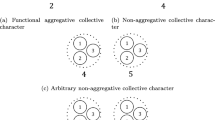Abstract
Multi-level selection can be understood via the Price equation or contextual analysis, which offer incompatible statistical decompositions of evolutionary change into components of group and individual selection. Okasha (Evolution and the levels of selection, 2006) argued that each approach suffers from problem cases. I introduce further problem cases for the Price approach, arguing that it is appropriate for MLS 2 group selection but not MLS 1. I also show that the problem cases Okasha raises for contextual analysis can be resolved. For some such cases, however, it emerges that there is no determinate answer to the question of how much of the total selective effect was due to group selection compared to individual selection. This suggests that when there is interaction between the effect of group character and individual character, one cannot separate selection into distinct ‘levels’ at all.

Similar content being viewed by others
Notes
The general decomposition is \(\hbox {w}_{\mathrm{i} }=-srZ_i^2 +srz_i Z_i +\left( {\frac{s}{2}-tr} \right) Z_i +trz_i +t/2\), where \(\hbox {r}=2\hbox {p}-1\).
References
Boyd, L. H., & Iversen, G. R. (1979). Contextual analysis: Concepts and statistical techniques. Belmont, CA: Wadsworth.
Damuth, J., & Heisler, I. L. (1988). Alternative formulations of multilevel selection. Biology and Philosophy, 3, 407–430.
Goodnight, C. J., Shwartz, J. M., & Stevens, L. (1992). Contextual analysis of models of group selection, soft selection, hard selection, and the evolution of altruism. American Naturalist, 140, 743–761.
Hamilton, W. D. (1963). The evolution of altruistic behaviour. American Naturalist, 97, 354–356.
Hamilton, W. D. (1964). The genetical evolution of social behaviour, I and II. Journal of Theoretical Biology, 7, 1–52.
Heisler, I. L., & Damuth, J. (1987). A method for analyzing selection in hierarchically structured populations. The American Naturalist, 130(4), 582–602.
Lewontin, R. C. (1970). The units of selection. Annual Review of Ecology and Systematics, 1, 1–18.
Nunney, L. (1985). Group selection, altruism, and structured-deme Models. American Naturalist, 126, 212–230.
Okasha, S. (2006). Evolution and the levels of selection. Oxford: Clarendon Press.
Price, G. R. (1970). Selection and covariance. Nature, 227, 520–521.
Queller, D. C. (1985). Kinship, reciprocity and synergism in the evolution of social behavior. Nature, 318, 366–367.
Smith, M. (1964). Group selection and kin selection. Nature, 201, 1145–1147.
Sober, E. (2011). Realism, conventionalism, and causal decomposition in units of selection: Reflections on Samir Okasha’s evolution and the levels of selection. Philosophy and Phenomenological Research, 82(1), 221–231.
Sober, E. (1984). The nature of selection. Cambridge, MA: The MIT Press.
Sober, E., & Wilson, D. S. (1998). Unto others: The evolution and psychology of unselfish behavior. Cambridge, MA: Harvard University Press.
Stephens, C. (2004). Selection, drift, and the “forces” of evolution. Philosophy of Science, 71, 550–570.
Wade, M. J., Goodnight, C. J., & Stephens, L. (1999). Design and interpretation of experimental studies of interdemic selection: A reply to Getty. American Naturalist, 154, 599–603.
West, A., Griffin, A. S., & Gardner, A. (2006). Social Semantics: Altruism, cooperation, mutualism, strong reciprocity and group selection. Journal of Evolutionary Biology, 20, 415–432.
Williams, G. C. (1966). Adaptation and natural selection. Princeton: Princeton University Press.
Wilson, D. S. (1975). A theory of group selection. Proceedings of the Natural Academy of Sciences USA, 72, 143–146.
Wilson, D. S. (1980). The natural selection of populations and communities. Menlo Park, CA: Benjamin Cummings.
Wilson, R. A. (2003). Pluralism, entwinement, and the levels of selection. Philosophy of Science, 70, 531–552.
Author information
Authors and Affiliations
Corresponding author
Rights and permissions
About this article
Cite this article
Earnshaw, E. Group selection and contextual analysis. Synthese 192, 305–316 (2015). https://doi.org/10.1007/s11229-014-0569-0
Received:
Accepted:
Published:
Issue Date:
DOI: https://doi.org/10.1007/s11229-014-0569-0




